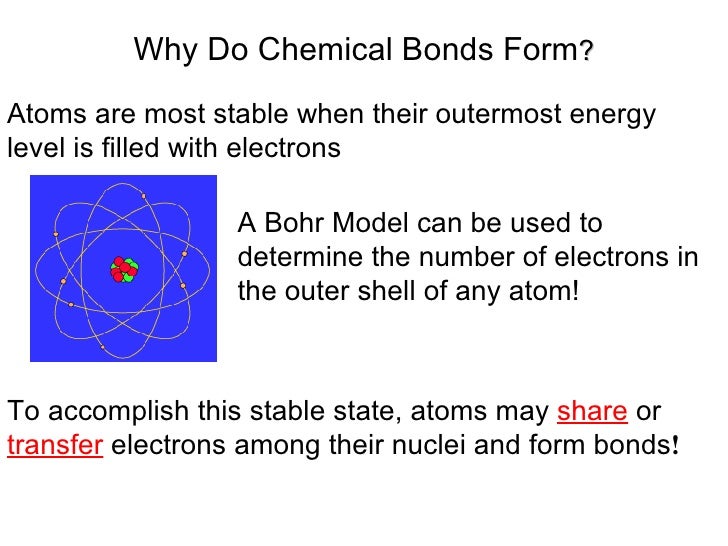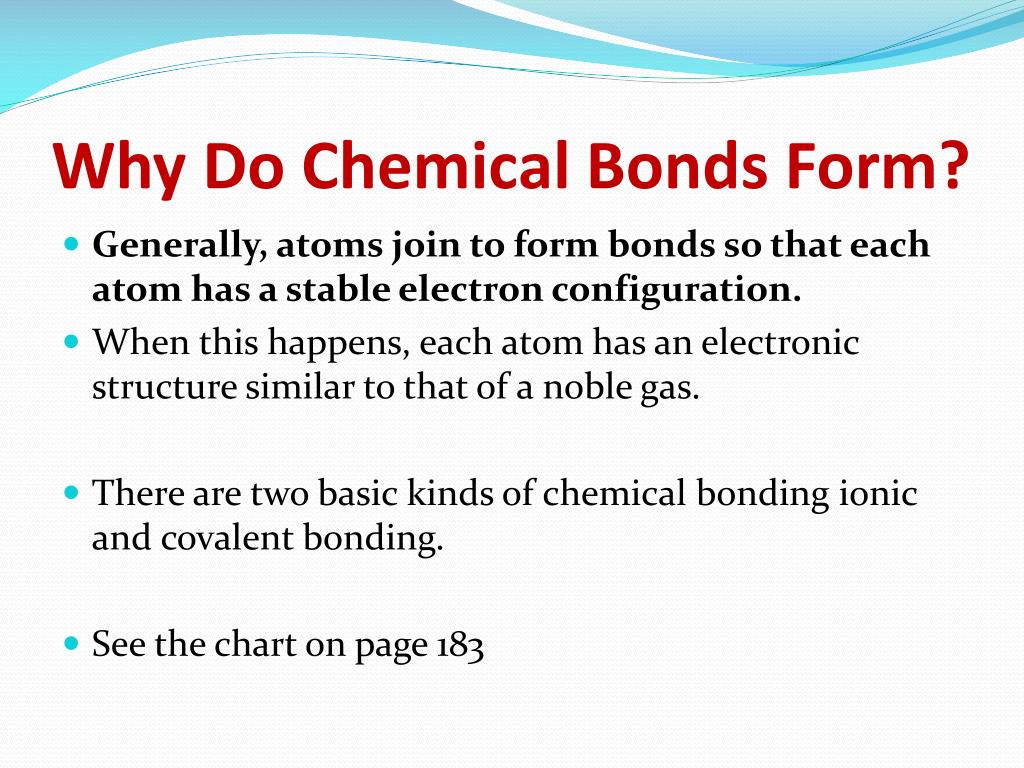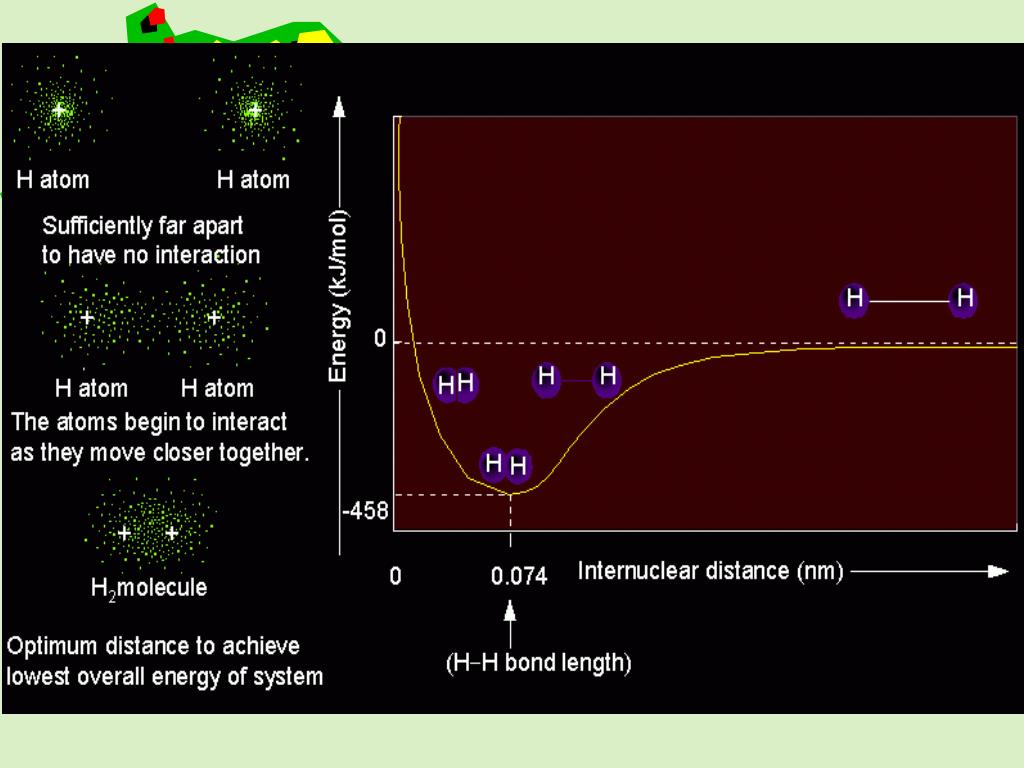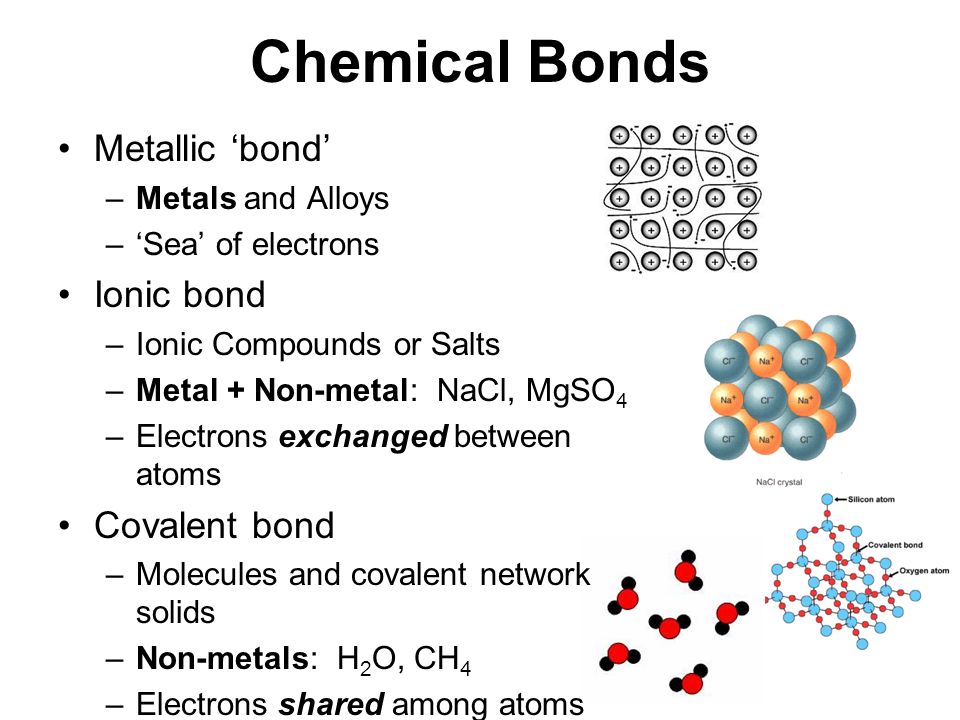Why Do Chemical Bonds Form
Why Do Chemical Bonds Form - Interpreting potential energy curves of diatomic molecules (opens a modal) lattice energy (opens a modal) ionic bonds and coulomb's law (opens a modal) practice. Web all models of chemical bonding have three common features: Intramolecular force and potential energy. Bonds form when atoms share or transfer valence electrons. The attractive forces that hold chemicals together drive the properties of each substance here is an artist’s renderings of hydrogen molecules — pairs of hydrogen atoms held together by a chemical bond. However, the flame itself is a chemical reaction because the fuel no longer exists once burned. Valence electrons are the electrons in the outer energy level of an atom that may be involved in chemical interactions. The type of chemical bond maximizes the stability of the atoms that form it. Web types of chemical bonds. Bond length and bond energy (opens a modal) worked example:
Many atoms become stable when their valence shell is filled with electrons or when they satisfy the. Web types of chemical bonds. Intramolecular force and potential energy. Bonds form when atoms share or transfer valence electrons. Bond length and bond energy (opens a modal) worked example: However, the flame itself is a chemical reaction because the fuel no longer exists once burned. Web no, it is a physical reaction because you still have water. The bond may result from the electrostatic force between oppositely charged ions as in ionic bonds, or through the sharing of electrons as in covalent bonds. Web all models of chemical bonding have three common features: Atoms form bonds because the products are more stable than the isolated atoms;
Bonds form when atoms share or transfer valence electrons. Web chemical bonding, any of the interactions that account for the association of atoms into molecules, ions, crystals, and other species. However, the flame itself is a chemical reaction because the fuel no longer exists once burned. When atoms approach one another, their electrons interact and tend to distribute themselves in space so that the total energy is lower than it would be in any alternative arrangement. Intramolecular force and potential energy. Bonding interactions are characterized by a particular energy (the bond energy or lattice energy), which is the amount of energy required to dissociate the substance into its components; Valence electrons are the electrons in the outer energy level of an atom that may be involved in chemical interactions. An ionic bond, where one atom essentially donates an electron to another, forms when one atom becomes stable by losing its outer electrons and the other atoms become stable (usually by filling. Valence electrons are the basis of all chemical bonds. Web atoms form chemical bonds to make their outer electron shells more stable.
Biochemistry Honors
Many atoms become stable when their valence shell is filled with electrons or when they satisfy the. This type, consisting of a shared pair of electrons, is known as a covalent bond. The bond may result from the electrostatic force between oppositely charged ions as in ionic bonds, or through the sharing of electrons as in covalent bonds. When atoms.
11 6 Chemical Bonding Review
Web why form chemical bonds? Interpreting potential energy curves of diatomic molecules (opens a modal) lattice energy (opens a modal) ionic bonds and coulomb's law (opens a modal) practice. Web atoms form chemical bonds to make their outer electron shells more stable. Valence electrons are the basis of all chemical bonds. Web a chemical bond is a lasting attraction between.
PPT The Structure of Matter Chapter 6 PowerPoint Presentation, free
Many atoms become stable when their valence shell is filled with electrons or when they satisfy the. Web all models of chemical bonding have three common features: A chemical reaction occurs when you no longer have the same substance or substances, but have some new substance or substances. Web a chemical bond is a force of attraction between atoms or.
PPT Chemical Bonding Basic Concepts PowerPoint Presentation, free
Web a chemical bond is a force of attraction between atoms or ions. Web all models of chemical bonding have three common features: Bonds form when atoms share or transfer valence electrons. Intramolecular force and potential energy. Bonding interactions are characterized by a particular energy (the bond energy or lattice energy), which is the amount of energy required to dissociate.
Chemistry B.Sc Level How many types of chemical bond
Valence electrons are the electrons in the outer energy level of an atom that may be involved in chemical interactions. Web a chemical bond is a force of attraction between atoms or ions. Web a chemical bond is a force of attraction between atoms or ions. An ionic bond, where one atom essentially donates an electron to another, forms when.
Chemical Bonds foldable
Bonding interactions are characterized by a particular energy (the bond energy or lattice energy), which is the amount of energy required to dissociate the substance into its components; Atoms form bonds because the products are more stable than the isolated atoms; Web types of chemical bonds. The bond may result from the electrostatic force between oppositely charged ions as in.
Why Do Atoms Form Chemical Bond ,By chemistry with concept. YouTube
Web a chemical bond is a lasting attraction between atoms or ions that enables the formation of molecules, crystals, and other structures. Valence electrons are the electrons in the outer energy level of an atom that may be involved in chemical interactions. The type of chemical bond maximizes the stability of the atoms that form it. Bond length and bond.
Bonds Definition and Examples in Chemistry Chemical bond, Chemistry, Bond
Web chemical bonding, any of the interactions that account for the association of atoms into molecules, ions, crystals, and other species. The bond may result from the electrostatic force between oppositely charged ions as in ionic bonds, or through the sharing of electrons as in covalent bonds. Web all models of chemical bonding have three common features: An ionic bond,.
What Are Chemical Bonds and Why Do They Form?
Valence electrons are the electrons in the outer energy level of an atom that may be involved in chemical interactions. Web a chemical bond is a lasting attraction between atoms or ions that enables the formation of molecules, crystals, and other structures. Bonds form when atoms share or transfer valence electrons. Web a chemical bond is a force of attraction.
PPT COMPOUNDS PowerPoint Presentation, free download ID6094192
When atoms approach one another, their electrons interact and tend to distribute themselves in space so that the total energy is lower than it would be in any alternative arrangement. Web types of chemical bonds. Web atoms form chemical bonds to make their outer electron shells more stable. Atoms form bonds because the products are more stable than the isolated.
Web No, It Is A Physical Reaction Because You Still Have Water.
Bonds form when atoms share or transfer valence electrons. Intramolecular force and potential energy. Bonds form when atoms share or transfer valence electrons. Web all models of chemical bonding have three common features:
This Type, Consisting Of A Shared Pair Of Electrons, Is Known As A Covalent Bond.
Interpreting potential energy curves of diatomic molecules (opens a modal) lattice energy (opens a modal) ionic bonds and coulomb's law (opens a modal) practice. Valence electrons are the basis of all chemical bonds. Web types of chemical bonds. Valence electrons are the electrons in the outer energy level of an atom that may be involved in chemical interactions.
When Atoms Approach One Another, Their Electrons Interact And Tend To Distribute Themselves In Space So That The Total Energy Is Lower Than It Would Be In Any Alternative Arrangement.
Bond length and bond energy (opens a modal) worked example: Web atoms form chemical bonds to make their outer electron shells more stable. Web a chemical bond is a lasting attraction between atoms or ions that enables the formation of molecules, crystals, and other structures. A chemical reaction occurs when you no longer have the same substance or substances, but have some new substance or substances.
An Ionic Bond, Where One Atom Essentially Donates An Electron To Another, Forms When One Atom Becomes Stable By Losing Its Outer Electrons And The Other Atoms Become Stable (Usually By Filling.
Web chemical bonding, any of the interactions that account for the association of atoms into molecules, ions, crystals, and other species. Web a chemical bond is a force of attraction between atoms or ions. Many atoms become stable when their valence shell is filled with electrons or when they satisfy the. Web a chemical bond is a force of attraction between atoms or ions.









